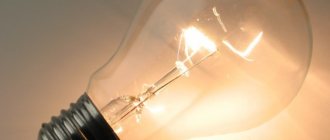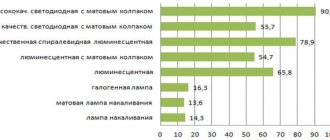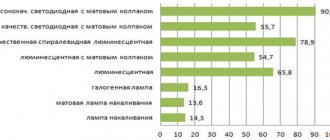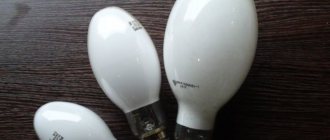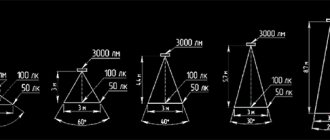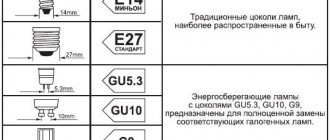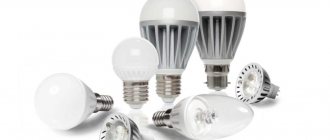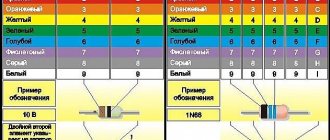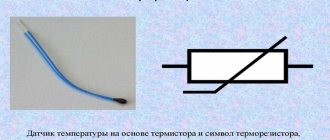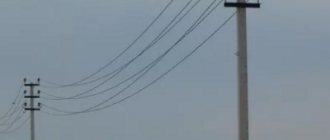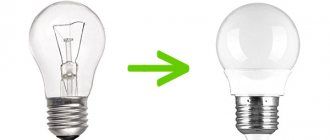The incandescent lamp is the first electric lighting device that plays an important role in human life. It is this that allows people to go about their business regardless of the time of day.
Compared to other light sources, this device is characterized by simplicity of design. The luminous flux is emitted by a tungsten filament located inside a glass bulb, the cavity of which is filled with a deep vacuum. Later, to increase durability, instead of vacuum, special gases began to be pumped into the flask - this is how halogen lamps appeared. Tungsten is a heat-resistant material with a high melting point. This is very important, because in order for a person to see the glow, the thread must become very hot due to the current passing through it.
History of creation
Interestingly, the first lamps did not use tungsten, but a number of other materials, including paper, graphite and bamboo. Therefore, despite the fact that all the laurels for the invention and improvement of the incandescent lamp belong to Edison and Lodygin, it is wrong to attribute all the merits only to them.
We will not write about the failures of individual scientists, but we will give the main directions in which the efforts of the men of that time were made:
- The search for the best filament material. It was necessary to find a material that was both resistant to fire and characterized by high resistance. The first thread was created from bamboo fibers, which were covered with a thin layer of graphite. Bamboo acted as an insulator, graphite as a conductive medium. Since the layer was small, the resistance increased significantly (as required). Everything would be fine, but the wood base of the coal led to rapid ignition.
- Next, the researchers thought about how to create conditions of the strictest vacuum, because oxygen is an important element for the combustion process.
- After this, it was necessary to create the connector and contact components of the electrical circuit. The task was complicated by the use of a layer of graphite, which is characterized by high resistance, so the scientists had to use precious metals - platinum and silver. This increased the current conductivity, but the cost of the product was too high.
- It is noteworthy that the Edison base thread is still used to this day - marked E27. The first methods of creating a contact involved soldering, but in this situation today it would be difficult to talk about quickly replaceable light bulbs. And with strong heating, such compounds would quickly disintegrate.
Nowadays, the popularity of such lamps is falling exponentially. In 2003, in Russia the amplitude of the supply voltage was increased by 5%; today this parameter is already 10%. This led to a reduction in the life of the incandescent lamp by 4 times. On the other hand, if you return the voltage to an equivalent value down, the luminous flux output will be significantly reduced - up to 40%.
Remember the training course - back in school, a physics teacher conducted experiments demonstrating how the glow of a lamp increases with increasing current supplied to the tungsten filament. The higher the current, the stronger the emission of radiation and the more heat.
Operating principle
The principle of operation of the lamp is based on the strong heating of the filament due to the electric current passing through it. In order for a solid material to begin to emit a red glow, its temperature must reach 570 degrees. Celsius. The radiation will be pleasant to the human eye only if this parameter is increased by 3–4 times.
Few materials are characterized by such refractoriness. Due to the affordable pricing policy, the choice was made in favor of tungsten, whose melting point is 3400 degrees. Celsius. To increase the area of light emission, the tungsten filament is twisted into a spiral. During operation, it can heat up to 2800 degrees. Celsius. The color temperature of such radiation is 2000–3000 K, which gives a yellowish spectrum - incomparable with daylight, but at the same time does not have a negative effect on the visual organs.
Once in the air, tungsten quickly oxidizes and breaks down. As mentioned above, instead of a vacuum, a glass flask can be filled with gases. We are talking about inert nitrogen, argon or krypton. This allowed not only to increase durability, but also to increase the glow strength. The service life is affected by the fact that gas pressure prevents the evaporation of the tungsten filament due to the high glow temperature.
The device of a lamp with a filament
Until recently, incandescent lamps (Il) were used everywhere and now they are still being bought - they can work both “at full strength”, brightly illuminating the room, and reduce the brightness using a dimmer. Due to the prevalence of traditional light bulbs among the population, many are familiar with their design features.
Moreover, we often had to “get acquainted” because the light source failed: the tungsten filament burned out, the glass burst, or the bulb flew out of the base.
Some manufacturers used more reliable and proven materials and treated the production of incandescent light bulbs so responsibly that their products have been working for several decades. But this is the exception rather than the rule - today no guarantees are given for a long service life.
Schematic representation of the lamp indicating the main parts. The design of the artificial light source has remained almost unchanged since its invention; only the materials and composition of the gas filling the flask have been improved
The main operating element is the so-called filament body, mounted on holders and connected to the electrodes. When electricity is connected, voltage passes through it, causing both heating and glowing. For the radiation to become visible, the heating temperature must reach 570 °C.
Tungsten is recognized as the most heat-resistant metal. It begins to melt when heated to 3422 °C. To maximize the radiation area, but reduce the volume of the filament inside the glass bulb, it is twisted into a spiral.
The usual comfortable yellow light, which creates coziness in the home and is visually “warm”, occurs when the filament is heated to 2830-2850 °C
To protect tungsten from the oxidation process characteristic of metals, air is pumped out of the flask and replaced with vacuum or gas (krypton, argon, etc.). Vacuum filling technology is outdated; for household lamps, a mixture of nitrogen and argon or krypton is most often used.
As a result of testing, the minimum duration of lamp burning was identified - 1 thousand hours. But, taking into account random reasons that cause devices to fail ahead of time, it is assumed that the standards apply to only 50% of the products from each batch. The operating time of the second half may be longer or shorter, depending on the conditions of use.
Structure
A typical lamp consists of the following structural elements:
- flask;
- vacuum or inert gas pumped inside it;
- filament;
- electrodes - current terminals;
- hooks needed to hold the filament;
- leg;
- fuse;
- base, consisting of a housing, an insulator and a contact on the bottom.
In addition to standard versions made of conductor, glass vessel and leads, there are lamps for special purposes. Instead of a base, they use other holders or add an additional bulb.
The fuse is usually made of an alloy of ferrite and nickel and is placed in the gap on one of the current terminals. Often it is located in the leg. Its main purpose is to protect the flask from destruction in the event of a thread break. This is due to the fact that if it breaks, an electric arc is formed, leading to the melting of the remnants of the conductor, which fall on the glass bulb. Due to the high temperature, it may explode and cause a fire. However, for many years the low efficiency of fuses has been proven, so they are used less frequently.
Flask
The glass vessel is used to protect the filament from oxidation and destruction. The overall dimensions of the flask are selected depending on the deposition rate of the material from which the conductor is made.
Gas environment
If previously all incandescent lamps without exception were filled with vacuum, today this approach is used only for low-power light sources. More powerful devices are filled with inert gas. The molar mass of the gas affects the heat emitted by the filament.
Halogens are pumped into the bulb of halogen lamps. The substance with which the filament is coated begins to evaporate and interact with the halogens located inside the vessel. As a result of the reaction, compounds are formed that decompose again and the substance returns to the surface of the thread. Thanks to this, it became possible to increase the temperature of the conductor, increasing the efficiency and service life of the product. This approach also made it possible to make the flasks more compact. The design flaw is associated with the initially low resistance of the conductor when applying electric current.
Filament
The shape of the filament can be different - the choice in favor of one or the other depends on the specifics of the light bulb. They often use a thread with a round cross-section, twisted into a spiral, and much less often - ribbon conductors.
A modern incandescent lamp is powered by a filament made of tungsten or an osmium-tungsten alloy. Instead of conventional helices, bi-helices and tri-helices can be twisted, which is made possible by repeated twisting. The latter leads to a decrease in thermal radiation and an increase in efficiency.
Specifications
It is interesting to observe the relationship between light energy and lamp power. The changes are not linear - up to 75 W, the luminous efficiency increases, and if it is exceeded, it decreases.
One of the advantages of such light sources is uniform illumination, since light is emitted with equal strength in almost all directions.
Another advantage is associated with pulsating light, which at certain values leads to significant eye fatigue. The normal value is considered to be a ripple coefficient not exceeding 10%. For incandescent lamps the maximum parameter reaches 4%. The worst indicator is for products with a power of 40 W.
Of all the electrical lighting available, incandescent bulbs run the hottest. Most of the current is converted into thermal energy, so the device is more like a heater than a light source. Luminous efficiency ranges from 5 to 15%. For this reason, the legislation contains certain rules prohibiting, for example, the use of incandescent lamps of more than 100 W.
Typically, a 60 W lamp is enough to illuminate one room, which is characterized by slight heating.
When considering the emission spectrum and comparing it with natural light, two important observations can be made: the luminous flux of such lamps contains less blue and more red light. However, the result is considered acceptable and does not lead to fatigue, as is the case with daylight sources.
Operating Parameters
When using incandescent lamps, it is important to consider the conditions of their use. They can be used indoors and outdoors at temperatures not less than –60 and not more than +50 degrees. Celsius. In this case, air humidity should not exceed 98% (+20 degrees Celsius). The devices can operate in the same circuit with dimmers designed to regulate light output by changing the light intensity. These are cheap products that can be replaced independently even by an unqualified person.
Light flow
The direct purpose of any lighting device is lighting. In an incandescent lamp, it is created by converting thermal energy into luminous flux.
Luxmeter - a device for measuring the light output and pulsation of a light bulb
Definition and rules of measurement
Luminous flux is a quantity that characterizes the luminous power (light energy that is transferred through a certain surface per unit time by radiation) of visible radiation in the flow of this radiation, that is, according to the light sensation produced by the human eye.
The sensitivity of this sensation can be determined by the spectral efficiency curve, which is approved by the CIE. The unit of measurement of luminous flux in the International System of Units is lumen (lm or lm) , which is calculated by the formula:
1 lm = 1 cd*sr (1 lux × m2) , where:
- cd – candela;
- solid angle, 1 steradian.
The energy in a beam of light has a temporal and spatial distribution. Sources emitting luminous flux are distinguished by the distribution of spectral colors:
- line spectrum (individual lines);
- striped spectrum (nearby delimited lines);
- continuous spectrum.
The spectral density of a light beam is characterized by the distribution of the radiant flux over the spectrum. Measured in W/nm.
Correlation with element power
The increase in luminous flux directly depends on the power of the lamp. The graph (see figure below) shows a clear dependence of the increase in brightness in proportion to the increase in power.
Table - Dependence of the level of luminous flux and the power of an incandescent light bulb
| Incandescent lamp, W | Luminous flux (lm) | Lamp voltage, V |
| 40 | 610 | 12 |
| 40 | 570 | 36 |
| 40 | 340 | 230 |
| 40 | 400 | 240 |
| 60 | 955 | 36 |
| 60 | 735 | 225 |
| 60 | 645 | 230 |
| 60 | 711 | 235 |
| 60 | 670 | 240 |
| 75 | 940 | 220 |
| 75 | 960 | 225 |
| 100 | 1581 | 36 |
| 100 | 1381 | 225 |
| 100 | 1201 | 230 |
| 100 | 1361 | 235 |
| 150 | 2151 | 230 |
| 150 | 2181 | 240 |
| 200 | 2951 | 225 |
| 200 | 3051 | 230 |
| 300 | 3361 | 225 |
| 300 | 4801 | 230 |
| 300 | 4851 | 235 |
| 500 | 8401 | 220 |
| 750 | 13100 | 220 |
| 1000 | 18700 | 220 |
Incandescent lamps of the same power can emit different luminous fluxes. The higher the voltage, the higher the luminous flux value.
Comparison with other types of lamps
A comparative analysis of the luminous flux of incandescent lamps with more advanced fluorescent and LED lamps allows us to evaluate its effectiveness.
Table - Comparison of incandescent light bulbs with LED and fluorescent (energy-saving light bulbs)
| Incandescent lamp, power, W | LED lamp, power, W | Fluorescent lamp, power, W | Luminous flux, Lm (approximate value) |
| 20 | 2-3 | 4-7 | 251 |
| 40 | 3-5 | 10-14 | 399 |
| 60 | 7-11 | 14-16 | 701 |
| 75 | 11-13 | 19-21 | 899 |
| 100 | 13-16 | 25-35 | 1205 |
| 150 | 16-21 | 41-55 | 1805 |
| 200 | 21-30 | 59-80 | 2505 |
Luminous output level for different types of lighting elements
Kinds
There are several criteria for classifying incandescent lamps, which will be discussed below.
Depending on the lighting efficiency, incandescent lamps are classified (from worst to best):
- vacuum;
- argon or nitrogen-argon;
- krypton;
- xenon or halogen with an infrared reflector installed inside the lamp, which increases efficiency;
- with a coating designed to convert infrared radiation into the visible spectrum.
There are many more varieties of incandescent lamps related to their functional purpose and design features:
- General purpose - in the 70s. of the last century they were called “normal lighting lamps”. The most common and numerous category is products used for general and decorative lighting. Since 2008, the production of such light sources has decreased significantly, which was due to the adoption of numerous laws.
- Decorative purpose. The flasks of such products are made in the form of graceful figures. The most common types are candle-shaped glass vessels with a diameter of up to 35 mm and spherical ones (45 mm).
- Local appointment. The design is identical to the first category, but they are powered by a reduced voltage - 12/24/36/48 V. They are usually used in portable lamps and devices that illuminate workbenches, machines, etc.
- Illumination with painted bulbs. Often the power of products does not exceed 25 W, and for coloring the internal cavity is covered with a layer of inorganic pigment. It is much less common to find light sources whose outer part is painted with colored varnish. In this case, the pigment fades and crumbles very quickly.
- Mirrored. The bulb is made in a special shape, which is covered with a reflective layer (for example, by spraying aluminum). These products are used to redistribute the light flux and increase lighting efficiency.
- Signal. They are installed in lighting products intended to display any information. They are characterized by low power and are designed for long-term operation. Today they are practically useless due to the availability of LEDs.
- Transport. Another broad category of lamps used in vehicles. Characterized by high strength and vibration resistance. They use special bases that guarantee strong fastening and the ability to quickly replace them in cramped conditions. Can be powered from 6 V.
- Spotlights. High-power light sources up to 10 kW, characterized by high luminous efficiency. The spiral is laid compactly to ensure better focusing.
- Lamps used in optical devices, for example, film projection or medical equipment.
Special lamps
There are also more specific types of incandescent lamps:
- Switchboards are a subcategory of signal lamps used in switchboards and performing the functions of indicators. These are narrow, oblong and small-sized products with smooth parallel contacts. Due to this, they can be placed in buttons. Marked as “KM 6-50”. The first number indicates the voltage, the second indicates the amperage (mA).
- Incandescent or photographic lamp. These products are used in photographic equipment for normalized forced mode. It is characterized by high luminous efficiency and color temperature, but a short service life. The power of Soviet lamps reached 500 W. In most cases, the flask is frosted. Today they are practically not used.
- Projection. Used in slide projectors. High brightness.
The double-filament lamp comes in several varieties:
- For cars. One thread is used for the low beam, the other for the high beam. If we consider lamps for rear lights, then the threads can be used for the brake light and side light, respectively. An additional screen can cut off rays that in the low beam lamp can blind oncoming drivers.
- For airplanes. In a landing light, one filament can be used for low light, the other for high light, but requires external cooling and short operation.
- For railway traffic lights. Two threads are necessary to increase reliability - if one burns out, the other will glow.
Let's continue to consider special incandescent lamps:
- A headlight lamp is a complex design for moving objects. Used in automotive and aviation technology.
- Low inertia. Contains a thin filament. It was used in optical-type sound recording systems and in some types of phototelegraphy. Nowadays it is rarely used, since there are more modern and improved light sources.
- Heating. Used as a heat source in laser printers and copiers. The lamp has a cylindrical shape, is fixed in a rotating metal shaft, to which paper and toner are applied. The roller transfers heat, causing the toner to spread.
Main characteristics of incandescent lamps
Base
Lamp filament body
The filament body of the LN is made of the most refractory metal - tungsten, the melting point of which is 3653 K. The shorter and more compact the filament body and the larger its diameter, the higher the heating temperature it is designed for, and the more economical the lamp will be.
To increase compactness, a spiral (monospiral) or bispiral (double helix) filament body is often used. For LNs operating under the influence of vibration (transport systems), a rectilinear filament body is used.
The resistances of the LN spiral in the cold and heated (working) states differ significantly. So, for a 100 W LN they are 40 and 490 Ohms, respectively. The currents flowing through the lamp change accordingly. It can be assumed that the starting current of the LN is approximately 12.5 times higher than the operating mode current. This leads to the fact that the probability of LN failure at the moment of switching on increases sharply.
The most widely used is the threaded base of different diameters developed by Edison (letter E in the designation) (E27 - for LN with a power of 25...200 W, E40 - “goliath” - for LN with a power of more than 200 W, E14 - minion - for low-power LN).
The pin socket is used in transport systems, as it does not allow the lamp to unscrew from the socket.
A focusing base, which allows the lamp to be installed in a strictly defined position, is used in optical systems.
Electrical characteristics
1. The rated voltage Un LN of general lighting is, as a rule, 220 V. Voltage 127 V is used much less frequently, since the main voltage system is currently 380/220 V. For local and portable lighting, LNs with a rated voltage of 36.12 are used , 6 V.
Since the burning time of LNs sharply decreases with increasing input voltage, LNs are produced that are designed to operate in networks with increased voltage. The range of recommended voltages is indicated for them: 215...225 V, 220...230 V, 230...240 V, 125...135 V. For these lamps, the burning duration at a voltage coinciding with the middle of the range (it is called the calculated voltage) is equal to the burning duration of a conventional lamp at a voltage of 220 V. At a voltage that coincides with the left limit of the range, the burning duration of these lamps increases by 2.5...3.5 times, but their power, luminous flux (by about 25%) and luminous efficiency decrease. Lamps with a higher right limit of the rated voltage are recommended to be used at higher (compared to the rated) mains voltage. It is advisable to use them to extend the burning period of lamps in networks with rated voltage, especially at low values of the required illumination.
2. The rated power Rn of the LN varies in a wide range from fractions of a watt to 20 kW, since there are no fundamental obstacles to the manufacture of LN of any power. Since it is difficult to manufacture LNs in full compliance with the rated power specified for them, a deviation of the actual power from the rated power by ± 10% is allowed.
Lighting characteristics
1. The nominal luminous flux F n is indicated in reference books. As the lamp is used, it gradually decreases due to the evaporation of tungsten from the filament, which leads to a decrease in the lamp power and contamination of the bulb. After 750 hours of LN combustion, its luminous flux decreases by an average of 15%.
2. The maximum luminous intensity IMAK is set for LPs relatively rarely - mainly for LPs operating in the same type of optical systems, for example, for automotive LPs. In most cases, the maximum luminous intensity of a luminaire is determined by its luminous intensity curve and can differ significantly from the maximum luminous intensity of the LN.
3. Color temperature
In the radiation of the visible spectrum of LN, orange-red rays predominate, which enhance “warm” color tones (brown, orange, red) and weaken “cold” ones (violet, blue, green), which cannot provide good color rendition. The color temperature of LN lies in the range of 2500…2700 K.
Economic and operational characteristics
1. Nominal luminous efficiency (lm/W) - luminous flux per unit of power - is the most important economic characteristic of an IC, similar in meaning to efficiency. Therefore, it is denoted by the large Greek letter eta - H (small eta - η):
NN = FN/RN.
The luminous output of thermal emitters, even theoretically, cannot be more than 89.5 lm/W. For general purpose LNs, the luminous efficiency ranges from 8 to 20 lm/W and depends on the heating temperature of the filament (Fig. 28).
The filament body is heated to a greater extent in gas-filled lasers, where the evaporation of tungsten is difficult. In LNs with a lower rated voltage and a higher rated power, the filament body is shorter, more compact and has a larger diameter. Therefore, it is designed for high heating temperatures. The luminous efficiency of an incandescent lamp increases with decreasing rated voltage and increasing rated power.
Thus, the luminous efficiency of a 15 W LN with a rated voltage of 220 V (V220-15) is 8 lm/W, and for the G127-1000 it is 20 lm/W.
2. Burning duration τ – duration of actual use of the lamp, i.e. its resource (in contrast to its service life - the calendar duration from the start of use to failure).
Total burning time
– the burning duration of one separately considered lamp differs sharply for different LPs and cannot serve as a characteristic of the durability of the IC as a whole.
The average burning time τSR is determined for a batch of lamps. The average burning time is taken (Fig. 29) to be the total burning time of that lamp from the test batch for which the number of burnt-out lamps before and after it is the same. So, if 101 lamps are tested, then this is the total burning time of the 51st burnt out lamp. If 100 lamps are tested, then the average burning time of the batch is equal to the arithmetic mean between the total burning durations of the 50th and 51st burnt out lamps.
The average burning time of general-purpose LNs is 1000 hours at the design voltage.
Guaranteed burning time
General use LN is 700 hours.
Useful burning time
– duration of combustion, during which the luminous flux will drop by no more than 30%. For LN, the useful burning time is usually equal to the average, since the average value of the luminous flux over the entire period of operation is 0.87...0.95 of the nominal value.
Dependence of LN characteristics on network voltage
very significant.
Increasing the voltage supplied to the LN increases its luminous flux, power and luminous efficiency and sharply reduces the burning duration (Fig. 30).
These dependencies can be presented in the form of the following empirical formulas:
P/PN = (U/UN)1.58;
H/HH = (U/UH)2.03;
F/FN = (U/UН)3.61;
τ/τН=(U/UN)–(11.2÷14.8) .
If the network voltage increases by 3%, the burning time of the LN will be 60% of the nominal. If the network voltage decreases by 10%, the luminous flux of the LN will drop by 30%.
Base
Lamp filament body
The filament body of the LN is made of the most refractory metal - tungsten, the melting point of which is 3653 K. The shorter and more compact the filament body and the larger its diameter, the higher the heating temperature it is designed for, and the more economical the lamp will be.
To increase compactness, a spiral (monospiral) or bispiral (double helix) filament body is often used. For LNs operating under the influence of vibration (transport systems), a rectilinear filament body is used.
The resistances of the LN spiral in the cold and heated (working) states differ significantly. So, for a 100 W LN they are 40 and 490 Ohms, respectively. The currents flowing through the lamp change accordingly. It can be assumed that the starting current of the LN is approximately 12.5 times higher than the operating mode current. This leads to the fact that the probability of LN failure at the moment of switching on increases sharply.
The most widely used is the threaded base of different diameters developed by Edison (letter E in the designation) (E27 - for LN with a power of 25...200 W, E40 - “goliath” - for LN with a power of more than 200 W, E14 - minion - for low-power LN).
The pin socket is used in transport systems, as it does not allow the lamp to unscrew from the socket.
A focusing base, which allows the lamp to be installed in a strictly defined position, is used in optical systems.
Electrical characteristics
1. The rated voltage Un LN of general lighting is, as a rule, 220 V. Voltage 127 V is used much less frequently, since the main voltage system is currently 380/220 V. For local and portable lighting, LNs with a rated voltage of 36.12 are used , 6 V.
Since the burning time of LNs sharply decreases with increasing input voltage, LNs are produced that are designed to operate in networks with increased voltage. The range of recommended voltages is indicated for them: 215...225 V, 220...230 V, 230...240 V, 125...135 V. For these lamps, the burning duration at a voltage coinciding with the middle of the range (it is called the calculated voltage) is equal to the burning duration of a conventional lamp at a voltage of 220 V. At a voltage that coincides with the left limit of the range, the burning duration of these lamps increases by 2.5...3.5 times, but their power, luminous flux (by about 25%) and luminous efficiency decrease. Lamps with a higher right limit of the rated voltage are recommended to be used at higher (compared to the rated) mains voltage. It is advisable to use them to extend the burning period of lamps in networks with rated voltage, especially at low values of the required illumination.
2. The rated power Rn of the LN varies in a wide range from fractions of a watt to 20 kW, since there are no fundamental obstacles to the manufacture of LN of any power. Since it is difficult to manufacture LNs in full compliance with the rated power specified for them, a deviation of the actual power from the rated power by ± 10% is allowed.
Lighting characteristics
1. The nominal luminous flux F n is indicated in reference books. As the lamp is used, it gradually decreases due to the evaporation of tungsten from the filament, which leads to a decrease in the lamp power and contamination of the bulb. After 750 hours of LN combustion, its luminous flux decreases by an average of 15%.
2. The maximum luminous intensity IMAK is set for LPs relatively rarely - mainly for LPs operating in the same type of optical systems, for example, for automotive LPs. In most cases, the maximum luminous intensity of a luminaire is determined by its luminous intensity curve and can differ significantly from the maximum luminous intensity of the LN.
3. Color temperature
In the radiation of the visible spectrum of LN, orange-red rays predominate, which enhance “warm” color tones (brown, orange, red) and weaken “cold” ones (violet, blue, green), which cannot provide good color rendition. The color temperature of LN lies in the range of 2500…2700 K.
Economic and operational characteristics
1. Nominal luminous efficiency (lm/W) - luminous flux per unit of power - is the most important economic characteristic of an IC, similar in meaning to efficiency. Therefore, it is denoted by the large Greek letter eta - H (small eta - η):
NN = FN/RN.
The luminous output of thermal emitters, even theoretically, cannot be more than 89.5 lm/W. For general purpose LNs, the luminous efficiency ranges from 8 to 20 lm/W and depends on the heating temperature of the filament (Fig. 28).
The filament body is heated to a greater extent in gas-filled lasers, where the evaporation of tungsten is difficult. In LNs with a lower rated voltage and a higher rated power, the filament body is shorter, more compact and has a larger diameter. Therefore, it is designed for high heating temperatures. The luminous efficiency of an incandescent lamp increases with decreasing rated voltage and increasing rated power.
Thus, the luminous efficiency of a 15 W LN with a rated voltage of 220 V (V220-15) is 8 lm/W, and for the G127-1000 it is 20 lm/W.
2. Burning duration τ – duration of actual use of the lamp, i.e. its resource (in contrast to its service life - the calendar duration from the start of use to failure).
Total burning time
– the burning duration of one separately considered lamp differs sharply for different LPs and cannot serve as a characteristic of the durability of the IC as a whole.
The average burning time τSR is determined for a batch of lamps. The average burning time is taken (Fig. 29) to be the total burning time of that lamp from the test batch for which the number of burnt-out lamps before and after it is the same. So, if 101 lamps are tested, then this is the total burning time of the 51st burnt out lamp. If 100 lamps are tested, then the average burning time of the batch is equal to the arithmetic mean between the total burning durations of the 50th and 51st burnt out lamps.
The average burning time of general-purpose LNs is 1000 hours at the design voltage.
Guaranteed burning time
General use LN is 700 hours.
Useful burning time
– duration of combustion, during which the luminous flux will drop by no more than 30%. For LN, the useful burning time is usually equal to the average, since the average value of the luminous flux over the entire period of operation is 0.87...0.95 of the nominal value.
Dependence of LN characteristics on network voltage
very significant.
Increasing the voltage supplied to the LN increases its luminous flux, power and luminous efficiency and sharply reduces the burning duration (Fig. 30).
These dependencies can be presented in the form of the following empirical formulas:
P/PN = (U/UN)1.58;
H/HH = (U/UH)2.03;
F/FN = (U/UН)3.61;
τ/τН=(U/UN)–(11.2÷14.8) .
If the network voltage increases by 3%, the burning time of the LN will be 60% of the nominal. If the network voltage decreases by 10%, the luminous flux of the LN will drop by 30%.
Efficiency
Electric current in incandescent lamps is converted not only into light visible to the eye. One part is used for radiation, the other is transformed into heat, and the third is converted into infrared light, which is not detected by the visual organs. If the conductor temperature is 3350 K, then the efficiency of the incandescent lamp will be 15%. A conventional 60 W lamp with a temperature of 2700 K is characterized by a minimum efficiency of 5%.
The efficiency is enhanced by the degree of heating of the conductor. But the higher the heating of the filament, the shorter the service life. For example, at a temperature of 2700 K, a light bulb will illuminate for 1000 hours, at 3400 K - several times less. If you increase the supply voltage by 20%, the glow will double. This is irrational, since the service life will be reduced by 95%.
Advantages and disadvantages
Comparing individual types of incandescent lamps will allow you to choose the most suitable option, based on the required power and luminous efficiency. But all of the listed types of lamps have common advantages and disadvantages:
Pros:
- Affordable price. The cost of many lamps is within 2 USD. e.;
- Quick on and off. This is the most significant parameter in comparison with energy-saving lamps with long switching times;
- Small sizes;
- Easy replacement;
- Wide selection of models. Now there are decorative lamps (candle, retro curl and others), classic, matte, mirror and others.
Minuses:
- High power consumption;
- Negative effects on the eyes. In most cases, the matte or mirror surface of the incandescent lamp bulb will help;
- Low protection against voltage surges. To ensure the required level, a protection unit for the incandescent lamp is used, it is selected depending on the type;
- Short operational period;
- Very low efficiency. Most of the electrical energy is spent not on lighting, but on heating the bulb.
https://www.youtube.com/watch?v=ET-u92BP968
Advantages and disadvantages
On the one hand, incandescent lamps are the most affordable light sources, on the other hand, they are characterized by a lot of disadvantages.
Advantages:
- low cost;
- there is no need to use additional devices;
- ease of use;
- comfortable color temperature;
- resistance to high humidity.
Flaws:
- fragility - 700–1000 hours if all rules and operating recommendations are followed;
- weak light output - efficiency from 5 to 15%;
- fragile glass flask;
- possibility of explosion if overheated;
- high fire danger;
- Voltage drops significantly shorten the service life.
Areas of application
The E27 60 W incandescent lamp is the standard for most lighting devices used both at home and in industry. Nowadays, it is not difficult to choose the optimal option from the consumer’s point of view in terms of effect, durability or cost.
By areas of use of incandescent light bulbs, the following sections can be identified:
- General purpose. Household, local and decorative lighting in the broadest sense. Therefore, this is the most widespread type of lamps.
- For local lighting. They differ from the first category by lower voltage (about 12-36 watts). They are often installed in portable light sources, on various devices - for example, machines.
- Illumination lamps. They are equipped with colored flasks. As a rule, low-power (10-35 W) devices are mainly used for decorative, advertising or artistic purposes. Color is ensured by coating the inner surface of the flask with an inorganic coloring composition; less often, the flask is painted on the outside.
- Mirror incandescent lamps. Their difference lies in the addition of a reflective layer to part of the bulb from the inside to focus the light flux in the desired direction.
- Signal lamps. Low-power light sources with a long operating life for lighting devices. They are gradually giving way to LED lamps.
- Transport lamps. An extensive category of devices designed for use on almost all modern types of transport. They are highly durable and can use the vehicle’s on-board power grid (6-220 V).
- Spotlight lamps. They are distinguished by impressive power (10-60 kW).
- Lamps for optical devices. This category, for example, includes lamps for film projectors, which were very common just a few years ago. In addition, they are used in measuring devices, medical equipment, etc.
